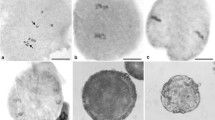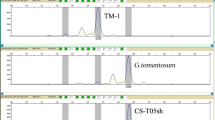Summary
1.Gossypium Davidsonii (n = 13), a wild species from California, has smaller chromosomes thanG. Sturtii (n = 13), a wild species from Australia. This difference in chromosome size is maintained in the hybrid, and enables a distinction between the paternal and the maternal chromosomes to be made.
2. The chromosome pairing in the hybrid is incomplete, but allosyndesis takes place about nine times more often than autosyndesis. Univalents are just as frequent between the small chromosomes fromG. Davidsonii, as between the larger chromosomes fromG. Sturtii.
3. The chiasma frequency is the same in the pure species despite the difference in chromosome size. Contrasted with the pure species, the chiasma frequency in the hybrid is significantly smaller in the bivalents containing aDavidsonii and aSturtii chromosome.
4. The difference in the size of the chromosomes of the species under observation is in all probability neither the result of genetic factors, nor associated with a difference in pairing blocks.
Similar content being viewed by others
References
Avery, P. (1930). “Cytological studies of five interspecific hybrids ofCrepis Leontodontoides.”Univ. Calif. Publ. agric. Sci.6, 135–67.
Berg, K. H. von (1931). “Autosyndese inAegilops triuncialis L. ×Secale cereale L.”Z. Zücht. A17, 55–69.
Darlington, C. D. (1932a). “The control of the chromosomes by the genotype and its bearing on some evolutionary problems.”Amer. Nat.66, 25–51.
-- (1932b).Recent Advances in Cytology. 559 pp. London.
Harland, S. C. (1928). “Cotton notes.”Trop. Agriculture, Trin.,5, 200–1.
Harland, S. C. (1929). “A suggested method for the control of certain bollworms in cotton.”Emp. Cott. Gr. Rev.6, 333–4.
—— (1932). “The genetics ofGossypium.”Bibliogr. genet. 9, 107.
Harland, S. C. andAtteck, O. S. (1931). “Intergeneric hybrids betweenGossypium andThurberia.”Amer. Nat.65, 380–2.
Kihara, H. andLilienfeld, F. (1932). “Untersuchungen anAegilops ×Triticum-undAegilops-Aegilops-Bastarden.”Cytologia,3, 384–456.
Lewitsky, G. A. (1931). “An essay on cytological analysis of the fixing action of the chrom-acetic formalin and the chromic-formalin.”Bull. Appl. Bot. and Plant Breed.27, 181–5.
Longley, A. E. (1933). “Chromosomes inGossypium and related genera.”J. agric. Res.46, 217–27.
Meurman, O. (1928). “Cytological studies in the genusRibes L.”Hereditas,11, 289–356.
Skovsted, A. (1929). “Cytological investigations of the genusAesculus L.” Ibid.12, 64–70.
—— (1933). “Cytological studies in cotton. I. The mitosis and the meiosis in diploid and triploid Asiatic cotton.”Ann. Bot., Lond.,47, 227–51.
—— (1934). “Cytological studies in cotton. II. Two interspecific hybrids between Asiatic and New World cottons.”J. Genet. 28, 407–24.
Author information
Authors and Affiliations
Rights and permissions
About this article
Cite this article
Skovsted, A. Cytological studies in cotton. Journ. of Genetics 30, 397–405 (1935). https://doi.org/10.1007/BF02982248
Issue Date:
DOI: https://doi.org/10.1007/BF02982248




